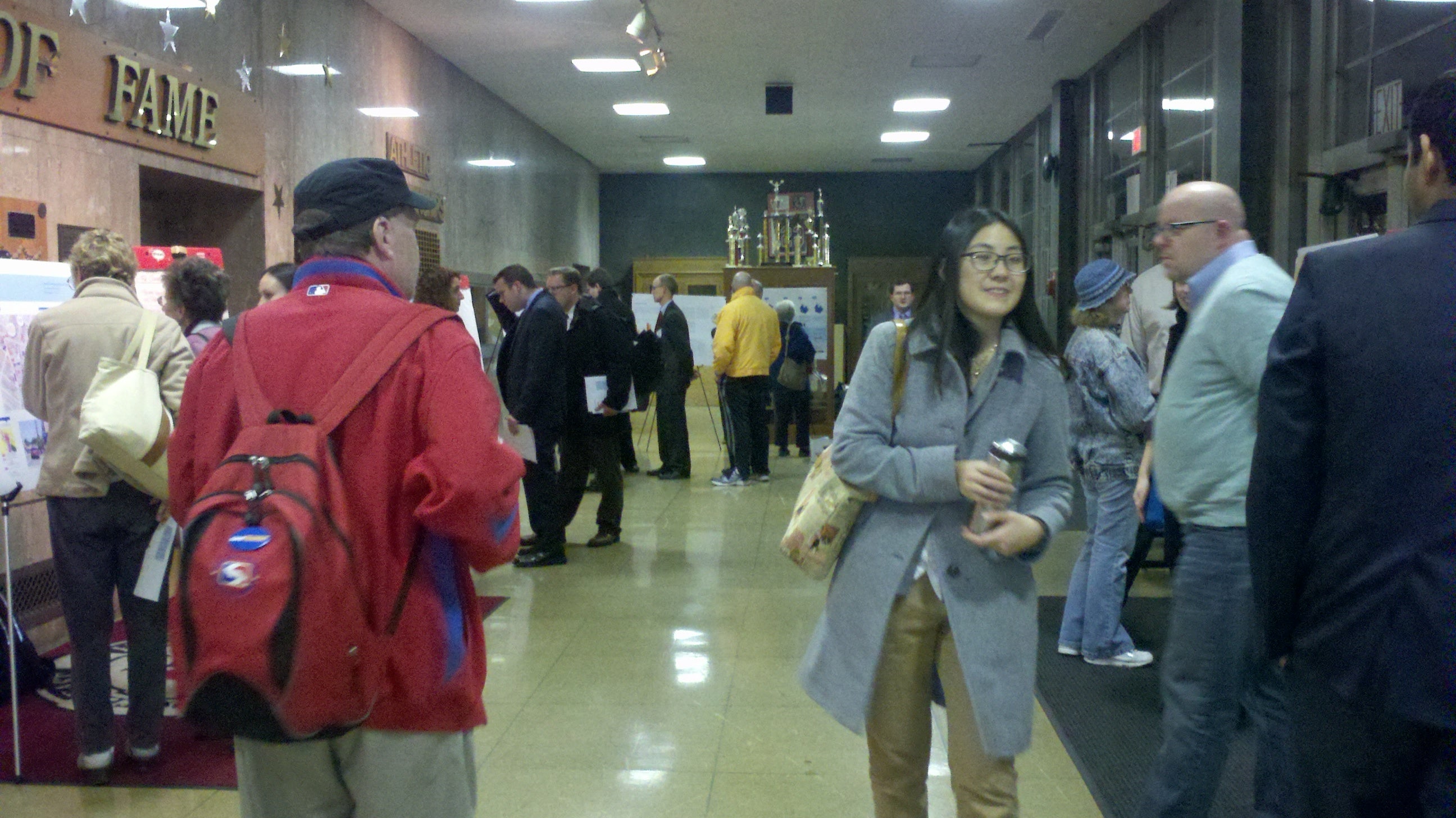Suggestions, praise, criticism at final Central Northeast meeting

Highlights of a still-under-construction draft plan calling for strengthened commercial corridors in Fox Chase/Rockledge, Five Points and Rhawnhurst, better mass transit, and a safer Roosevelt Boulevard for all who use or cross it were presented at Northeast Philadelphia High School Tuesday evening.
The Central Northeast District Plan imagines these improvements and others for the Central Northeast portion of Philadelphia, a planning district that includes Fox Chase, Burholme, Rhawnhurst, Lexington, Bells Corner, and the northern portions of Lawndale, Upper Northwood and Castor Gardens.
In the high school auditorium Tuesday, city planners stood next to posters with photos, graphics and text outlining the prospective planning goals and zoning changes so they could answer questions and take comments from the community members who came to see the recommendations. The draft plan is the result of a series of public meetings and other get togethers with community and business leaders, plus city planners’ own research, said community planner and Central Northeast Project Manager Michael Thompson.
Foxchase resident Jean Gavin did not like the format of the presentation; she said a simple list of ideas organized by neighborhood would have been easier to understand. But the projects she believes are most important for her neighborhood – additional parking for the Foxchase SEPTA train station and a trail to replace the unused tracks from the station north to Lorimer Park in Montgomery County – are both in the draft recommendations.
Gavin, a member of the Foxchase Homeowners Association and Save Burholme Park, has lived in the neighborhood for 20 years. There is not near enough parking at the SEPTA station to meet the demand, she said. As a result, transit-riders park on Rhawn, Oxford and other major commercial streets. “There is no parking on those streets for shoppers,” she said. More lot spaces would both encourage more transit ridership and help some of the commercial districts the plan hopes to improve, Gavin said.
A rail trail to Lorimer Park would give residents safe access to the park’s 230 acres, she said, while giving them a safe place to walk, jog or ride a bicycle.
Thompson said the plan urges SEPTA to increase parking at all three SEPTA train stations in the district. SEPTA has said they don’t have the money, he said. Gavin’s been told the same, but she said the gas tax recently passed by the state legislature for transportation projects should provide it.
SEPTA has committed to a trail on at least part of the land where the unused tracks are, Thompson said. “That is a go.”
Transit use is not as high in the district as it is in other parts of the city, he said, while meanwhile, the Boulevard is becoming crowded with cars, and is not a safe place for pedestrians and cyclists.
So other mass transit-related plan recommendations include bus rapid transit for The Boulevard, and support for SEPTA to expand its Transit First Initiative that gives bus drivers the ability to change traffic signals to green so they can travel more quickly. Transit First is already on the 58 bus.
State Rep. Mark Cohen said public transportation would also help the area’s growing immigrant population, some of whom do not drive. New immigrants make up much of the 8 percent increase in the district’s population since 1980, planners have said, and other plan recommendations include providing assistance for those who have or may want to start businesses. The idea is to make the Central Northeast a place that becomes a permanent home for these new residents and their children and grandchildren,Thompson said in an earlier interview.
Speaking of business, planners think with a little support from the city and buy-in from property owners, some of the district’s commercial corridors could evolve from serving their neighborhoods only to becoming regional draws.
Both Cohen and Northeast Chamber of Commerce President Al Taubenberger said Tuesday they support the commercial-area improvements the current draft of the plan suggests.
Cohen said the commercial areas along the Boulevard are already regional draws, but they could certainly become strengthened to bring in even more people.
“I support the goals for improving Cottman Avenue,” Cohen said. “A lot of people feel Cottman has a lot of unrealized potential.”
“I like what I’m seeing,” Taubenberger said.
Part of the business corridor suggestions include encouraging mixed-use residential/commercial development, particularly around transit nodes.
This suggestion really rankles Take Back Your Neighborhood Zoning Committee Chairman Robert Rudnitsky. Rudnitsky said the area around Bustleton and Cottman should remain “strictly commercial,” and the city should concentrate on enforcing zoning rules that prevent single-family homes from being divided into multi-family units. Rudnitsky says requests to divide single homes come before his civic group regularly, and they always deny, but sometimes, divisions are made illegally.
There is enough empty housing stock to accommodate the projected future population growth of the district, which comes to about 450 new people per year, he said. “They should see our foreclosure list,” Rudnitsky said.
Planners Thompson and Martin Gregorski said the vacancy property rate is actually not very high in the Central Northeast, and mixed-use development of market-rate apartments plus retail is proposed as a way to alleviate the pressure to divide single-family houses into rental units. Documents on the proposed plan list preserving single family housing stock as a goal. One tool: Marketing home improvement resources including incentives for home rehabilitation.
Taubenberger said he supports the mixed-use development proposals, noting that he grew up above his parents’ deli.
Commerce Department Business Services Manager Sandi King, a plan advisor, said mixed-use development creates a business district that always has “ a lot of people in the area.” Coupled with other planned improvements to sidewalks, bus station shelters and beautification projects, this “makes it a destination. You want to be there,” she said.
The Central Northeast plan is one of 18 district-level plans that are or will be part of Philadelphia’s city-wide comprehensive plan, which maps out development goals from now until 2035.
All the plans so far have included recommending zoning changes. This one has the least so far, as planners believe most of the zoning is already correct. (Most of it is a vast sea of single family homes.) There are some changes suggested in commercial areas that would re-zone from strip-mall commercial to neighborhood-style commercial and, at some corners, would allow three-stories rather than the current two and prohibit automotive-related uses, such as gas stations. The strip-mall to neighborhood commercial suggestion would make the zoning match the actual current land use, planners said.
There has been a time change for the Central Northeast plan. The draft plan will be presented to Philadelphia City Planning Commissioners at their Jan. 21st meeting, and the full document will be made public that day. It will be posted here at the Philadelphia2035 website, and comments can be emailed to Thompson at michael.thompson@phila.gov through Feb. 28, when the public comment period closes. (The Philadelphia 2035 already has some information on the plan, including previous presentations and summaries of public comment so far.)
The PCPC is expected to vote on plan adoption at their March 18 meeting.
WHYY is your source for fact-based, in-depth journalism and information. As a nonprofit organization, we rely on financial support from readers like you. Please give today.



